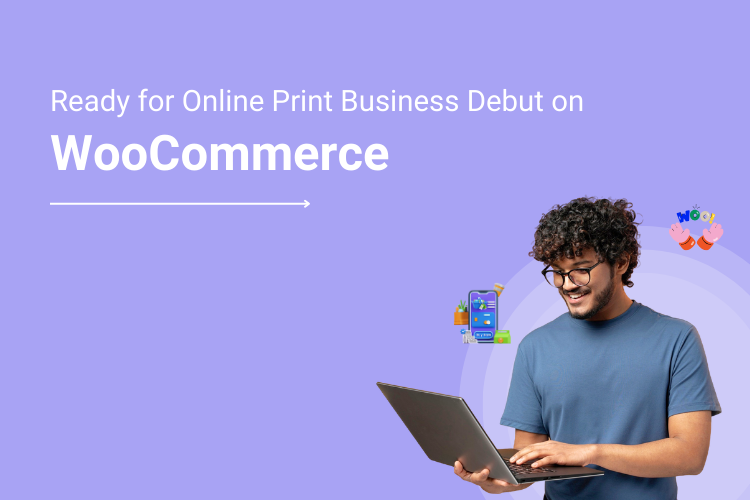Setting up your print business online can seem like a daunting task, but it isn’t if you have the right resources and guidance. In this article, a list of ‘essentials’ has been created so that you can have a smooth set-up and launch process of your online store.
Am I ready to start developing my online store?
Well, you only have to get an answer to this question by doing a thorough research and compiling the results as a single solution of the following:
- Discovering your niche, branding, domain name
- Estimating demand
- Competitor analysis and identifying USP
- Target market
- Resources and inventory
- E-commerce platform
- Budget
With this information in hand, you can move on to the first step.
Creating a Virtual Store
Just like in a brick-and-mortar store, you rent a place on the server with a domain name and create a web address. Once this is done, you start designing your store. Here is where the e-commerce platform plays its role. In your research, for an e-commerce platform, you may have come across options like Saas, open-source, and licensed. Although based on your finance and technical knowledge, you can choose whatever suits your needs but, WooCommerce for e-Commerce is an unbeatable match.
Why WooCommerce You May Ask?
WooCommerce is a standout choice when it comes to running websites of any kind. The free WordPress plugin WooCommerce is as if – made for e-commerce because it has all sorts of e-Commerce functionalities that one needs to step into the online market. It helps you manage your inventory, market your brand, is mobile-friendly, enabled with SEO tools, third-party app integration, various payment options, and security is already built-in and ready. You just have to configure them as per your store plan.
Moreover, by using a free or paid WooCommerce plugin or extension like – WordPress product designer, you can easily customize or expand your site as you seem fit. Such extensions and plugins are extremely helpful for online print businesses because the benefits they come along with are not just for owners but customers as well.
Here are some of the key benefits of installing a WooCommerce product designer extension:
- Customers can design their product without the requirement of technical or coding knowledge
- The custom made designs supports any kind of printing method
- It is easy to use on all devices
- It comes with a rich library of professional designs where designers can upload their artwork.
- It comes with a configuration panel to adjust the features as per one’s needs
Apart from this, many other plugins and extensions dealing with payments, shipments, delivery, packaging, product catalog, inventory management, etc., are available at WooCommerce, which are essential for running a successful print business that one must check out.
Additionally, you must set up your client management system, chalk out the best SEO strategies and use suitable tools to improve your ranking, select and acquire relevant data analytics tools, and consider mobile website development because today’s customers flock more through mobile than a laptop.
Now that the website is ready, you can move on to the next step:
Launching Your Online Print Store

It is important to have a go-live checklist while developing your website or even earlier so that the loopholes and errors are identified and resolved at the beginning itself. A habit of having a checklist not only helps in streamlining and organizing the process but also minimizes the chances of errors. So, let’s peek into the checklist.
Here’s your Go-live checklist:
1. Content & Media
Proofread all the content uploaded on your site. Correct all misspellings and grammatical mistakes because any error in it will spoil the first impression. Also, check whether images and videos have been adjusted to improve site loading speed.
2. Legalities
Check the copyrights of your images and videos on your site. Proofread the terms and conditions, check your data collection clauses, and whether your cookie warning is in place and working.
3. Contact
Contact numbers mentioned on the site should be active and functional. Check whether emails are not getting bounced.
4. Site usability
Go through the entire customer experience once you land on the site. Do a test run of each function. Check whether the navigations, design tools, checkout process, placing an order, call-to-action functions, landing page, and others are seamless to operate or not.
5. Functionality
Check for broken links, site-loading speed, forms, chats, error message work as they are supposed to if not fix them right away.
6. Mobile-friendliness
Check your site compatibility on mobile phones, and confirm whether the user experience is smooth.
7. Browser compatibility
Run your website on various browsers and its versions to check compatibility. Your website should at least be functional and pleasing on Chrome, Firefox, and Safari.
8. Security
Check your SSL certificate whether it is valid and functional. If you do not have a valid certificate then there are chances of your site being labeled as ‘Not secure’ which may drive away customers.
9. Optimize your metadata and check your XML/HTML sitemap
Your meta tags like the title tags and description, should be unique and must have the relevant keywords for your site to show up when users search for you. Along with that, check your XML/HTML sitemap for errors.
10. Plugins and extensions are working
Check how well your plugins and extensions work. If you have used the WooCommerce custom product designer extension, then check whether you can navigate through it easily, instructions are simple and the result is desirable. Also, remove any extension/plugin that is unnecessary.
11. Seo strategy
Research and curate a list of on and off-page SEO strategies to improve traffic and visibility from day 1 of the launch.
12. Build up the hype
Start marketing well beforehand. You could ask potential customers to sign up to be notified when the site is live. You can spread awareness through social media campaigns or start networking with influencers over various platforms to increase brand awareness.
Launch Day

Now that you have set up your store and have done a thorough checking, you are ready to go live in three…two…one…and CLICK!
Once you go live:
- Check whether your google analytics tools are collecting data or not.
- Check your conversion’s path is working properly – autoresponders are working, forms are submitting data properly, form data is being properly emailed.
- Check whether third-party integrations are working well. If you have created your website on WordPress and have used extensions, check whether they have properly established and are functional.
Other useful Blogs: You might also find the following blogs useful:
WooCommerce – People’s Choice for Global Print eCommerce Business
CONGRATULATIONS!
Your online store is up and running. Hopefully, this checklist will save you from the pain of grave mistakes and errors – This is what WooCommerce aims to provide for all its clients.

